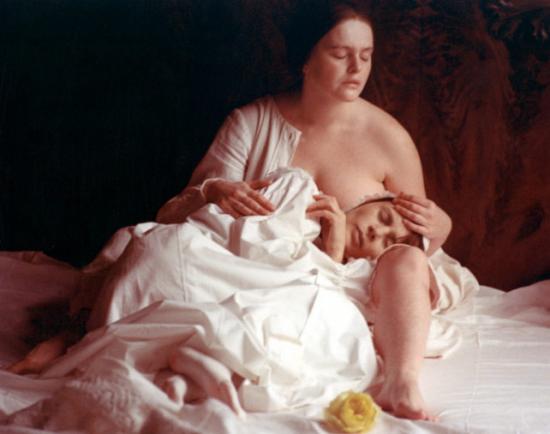All my films can be thought in terms of black and white, except for Cries and Whispers. In the screenplay, I say that I have thought of the color red as the interior of the soul. When I was a child, I saw the soul as a shadowy dragon, blue as smoke, hovering like an enormous winged creature, half bird, half fish. But inside the dragon, everything was red...Ingmar Bergman
The sick chamber is surrounded by clocks. This film is about the last two days in the life of a young woman, Agnes, dying of womb cancer. The clocks beat out an indifferent rhythm as the last scene of life's drama is being played out. Two sisters, Karen and Maria and a maid, Anna keep vigil over the patient.Sickness and death are climactic experiences. All the more so if they occur at a young age.
Tolstoi wrote that happy families are all similar but all unhappy families are unhappy in their own special ways. This movie is a story of physical and psychological pain in a group of four women brought into sharp relief by their comfortable economic position as well as the nearness of death-- of which we have no experience and for which we do not prepare. The palatial manor surrounded by sprawling manicured gardens and ancient trees with the sunshine pouring in shafts through the branches seem to mock the monstrous beings who live here and their depths of sordid emptiness. What an anamoly!
It is a grotesque drama of sterile, impoverished and distorted human relationships. Or is it a horrifying image of life, illuminted by rare flashes of lightening when life is capable of sublime or glorious things? It is as grim as a fairy tale. Bergman the artist rips off facade and sees life in it's many dimensions.
 The dying woman's mind wanders over the past searching for a moment of redemption. In the present she finds few straws to cling to. She is unprepared for dying and finally when it descends upon her like a catastrophe of nature, she is totally unprepared and in fact must resurrect like a Lazarus, so deep is her discontent. Even the heroic Anna finds the totality of her resources to be less than adequate. The final image of the film when Anna offers her body and breast to the soul whose need calls out from beyond the grave is of the pathetic helplessness of human beings in facing what they perforce must.
The dying woman's mind wanders over the past searching for a moment of redemption. In the present she finds few straws to cling to. She is unprepared for dying and finally when it descends upon her like a catastrophe of nature, she is totally unprepared and in fact must resurrect like a Lazarus, so deep is her discontent. Even the heroic Anna finds the totality of her resources to be less than adequate. The final image of the film when Anna offers her body and breast to the soul whose need calls out from beyond the grave is of the pathetic helplessness of human beings in facing what they perforce must.Roger Ebert's review
Roger Ebert: In Search of Redemption

2 comments:
Lovely words, my friend.
There is something about black and white photos, isn't it? I wish more people understood.
I really like Ingmar Bergman, you're making me want to watch all his films!
Don't Be a Plum
Post a Comment